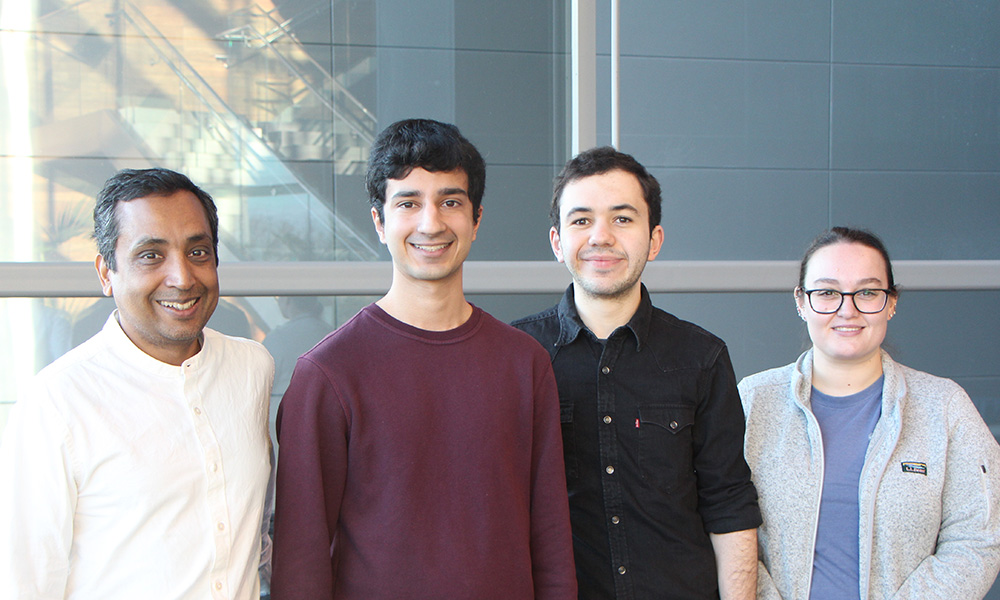Researchers in the Ramanathan Lab asked how the human embryo – and in particular an embryonic tissue called the neural tube, which gives rise to the spinal cord – elongates all by itself. They further asked why the neural tube elongates along a single axis and does not branch like the root of a plant. To investigate these questions, the team, led by graduate student Giri Anand, cultivated stem cells to mirror the process of axial elongation in the developing embryo. Their results were recently published in the journal Cell.
The human embryo that gives rise to our body begins as a single layer-thick sheet of cells. As it develops, it elongates along the head-to-tail axis, also known as the anterior-posterior axis. Among the multiple tissues that elongate is the neural tube, an embryonic precursor to the spinal cord.
Studying the human embryo directly is impossible, requiring in vitro embryonic stem cell systems to model development. “A fundamental challenge in the field is that such models using ‘wild type’ embryonic stem cells are extremely variable,” says MCB faculty and study co-author Sharad Ramanathan. “The embryonic stem cells often generate the cell types one wants, but most often, the tissue architecture is incorrect or does not exist. Thus making any sense of genetic perturbations in such a system to extract mechanistic insight is difficult.”
Anand started with human embryonic stem cells that he fashioned into an epithelial sheet of cells, like the early human embryo, folded into a cyst enclosing a single fluid-filled cavity called a lumen. He then positioned hundreds of such cysts on a glass surface and differentiated the cells with a posteriorizing signal. When he added this signal, every cyst reacted differently — some broke anterior-posterior symmetry, generating both anterior and posterior neural cells; others generated only anterior neural cells; and still others only posterior neural cells. “The anterior-posterior symmetry breaking of the cysts was awfully stochastic,” Ramanathan says.
Anand noticed, surprisingly, that anterior-posterior symmetry breaking seemed to depend on how the cysts were arranged on the glass, probably because the cysts were secreting signals and thus communicating with each other. Therefore he asked if one could learn how to arrange the cysts such that every one of the cysts broke anterior-posterior symmetry exactly as one wanted. Using tools from machine learning to analyze the data from randomly arranged cysts, Anand, along with co-authors Heitor Megale and Sean Murphy, predicted that arranging the cysts in a specific hexagonal pattern would lead the cysts to all break anterior-posterior symmetry, producing hundreds of identical axially elongating neural tube-like structures. They found that, indeed, each structure grew to a millimeter long in a week, mirroring the neural tube in vivo. With Jia Liu’s lab at SEAS, Anand and his colleagues then performed in situ sequencing to ascertain that the cell types and spatial gene expression profiles also mapped to what they expected based on in vivo studies on mammalian embryos.
By modulating signaling conditions, the team identified clusters of neuromesodermal progenitor (NMP)-like cells that produce signals such as WNT and FGF to direct the growth of the neural tube-like structures in the absence of external cues. In addition, the NMP-like cells themselves were induced by these signals, thus forming a positive feedback loop.
“In the absence of these sustaining signals [from the NMP-like cells], the structures truncate; they just stop elongating,” Anand explains, and signals have to be provided in the media for elongation to occur. However, once the NMP-like cells are induced, the process of elongation is kickstarted.
Positive feedback loops are notorious for generating instabilities. Anand and his colleagues found that WNT inhibitors suppressed the generation of ectopic NMP-like signaling centers. However once these inhibitors were genetically removed, NMP-like cells arose at various sites, giving rise to branched neural tubes. The scientists concluded that these WNT inhibitors are important for ensuring that the embryo only elongates along a single axis.
Ramanathan adds, “This study opens doors to understanding the axial elongation of the human embryo and a means to generate robust and reproducible organoids to study human development on a scale impossible in vivo.”
by Giri Anand, Diana Crow, and Sharad Ramanathan



